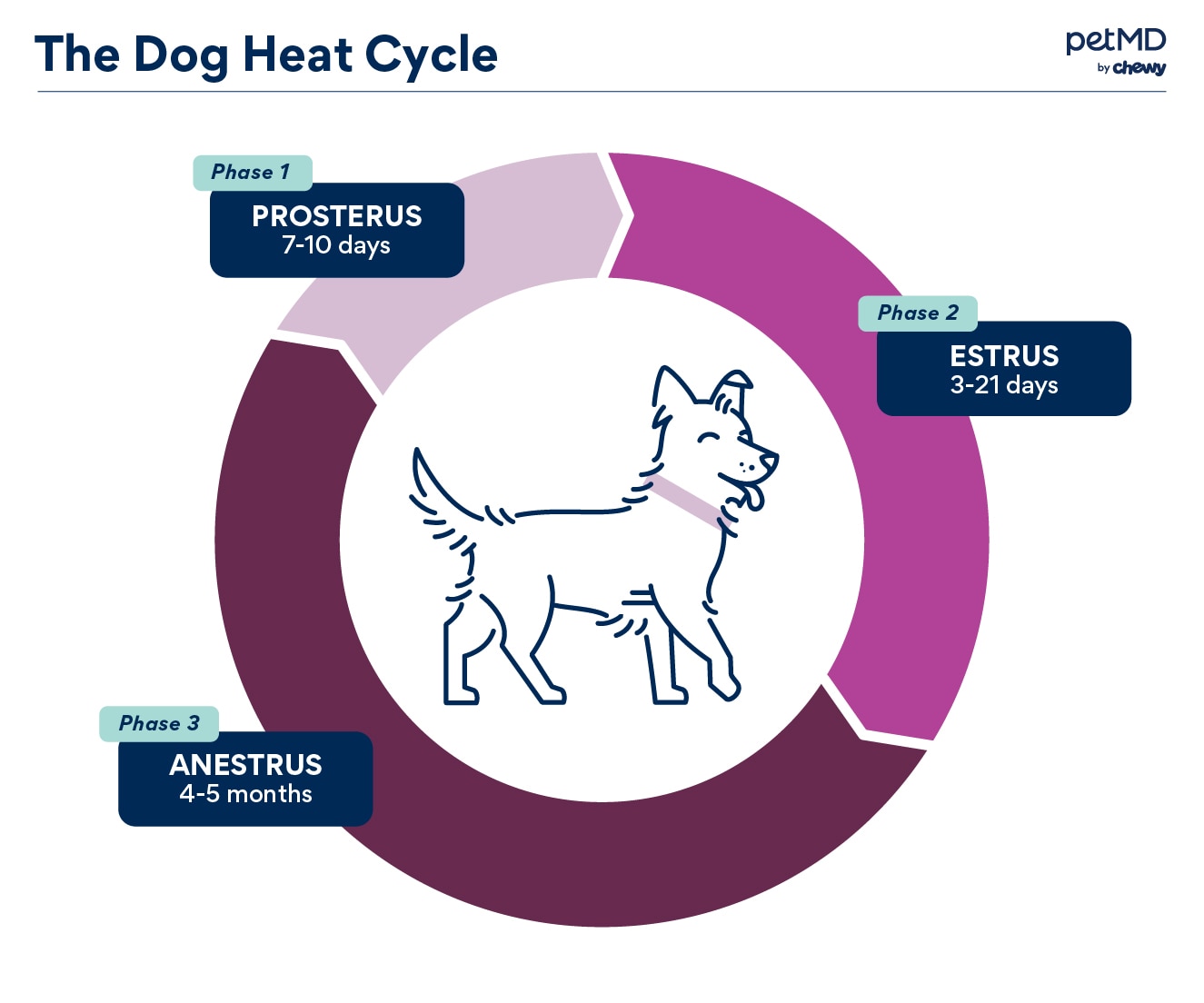Dogs in Heat: When It Happens, How Long It Lasts, and What To Do
Unless your female dog is spayed, she will go through a heat cycle. But what, exactly, does that mean?
There’s no short answer to explain the reproductive cycle of a female dog. Here’s a guide to help you better understand dog heat cycles and all the changes that come with them.
Health Tools
Not sure whether to see a vet?
When Do Dogs Go Into Heat?
While a human’s reproductive cycle lasts an average of 28 days, dogs are much different. Female dogs do not cycle every month, but usually only once or twice a year. On average, dogs go into heat every seven months.
Just as the duration of a human menstrual cycle varies from person to person, every dog is different. There can also be variations among breeds, and even variations from one cycle to another in the same animal.
Phases of a Dog’s Heat Cycle
A female dog’s reproductive cycle is called an estrous cycle and is broken down into three different phases:
-
Proestrus is the beginning of the heat cycle. It’s characterized by swelling of the vulva and a blood-tinged vaginal discharge. Female dogs will not allow mating to occur in this phase. This phase can last anywhere from a few days to four weeks. On average, it lasts seven to 10 days.
-
Estrus is also known as “heat.” This is the time when the female dog will allow mating to occur. This phase of the cycle lasts anywhere from three to 21 days, with an average length of nine days.
-
Anestrus is defined as the timeframe when cycling ceases. This phase usually lasts about four to five months, and there are no signs present.

How Do Male Dogs Know a Female Dog Is in Heat?
When a female dog is in heat, her vaginal and urinary secretions will contain different pheromones (chemicals released by the body) than when she is not in heat. Male dogs’ keen sense of smell can detect these pheromones.
What Happens When a Dog Goes Into Heat? How Can You Tell Your Dog Is in Heat?
Dog pheromones are undetectable to humans, but there are several other reliable ways to tell if your dog is in heat, including:
-
Physical changes: You may notice continued swelling of the vulva, bloody discharge, or even a change in the vulva’s color (usually to a straw-like hue). Your dog may also arch her body when pressure is applied to her lower back, and you may notice her moving her tail sideways.
-
Behavioral changes: Courtship-like behavior is often initiated by the female dog and may include releasing pheromones, vocalization, postural changes, increased physical activity, urinating in the presence of a male dog, or allowing male interest (such as allowing them to sniff or lick the vulva).
-
Diagnostic testing: Vaginal cytology (a procedure similar to a pap smear) is a low-cost, relatively quick monitoring tool that can be performed on an outpatient basis with the veterinarian.
When in doubt, consult your veterinarian.
At What Age Do Dogs Go Into Heat?
Dogs can have their first heat when they’re as young as 6 months old or as old as 24 months of age. Even though dogs can become pregnant during this timeframe, it’s generally not advisable, as they are still not fully mature.
The timing of a dog’s first heat varies, with size being a major factor. Small dog breeds tend of have their estrus cycle at an earlier age (around 6 months old), while large or giant-breed dogs may not come into heat until later (18–24 months).
Do Dogs Go Through Menopause?
Dogs do not go through menopause. Because their reproductive cycles are different than in humans, dogs can continue to go into heat and subsequently become pregnant throughout their lives, even into their senior years.
You may notice, however, that your dog’s cycle may occur less often, or the duration seems longer from one heat to the next. That’s normal in dogs as they age. But dogs that have stopped having cycles altogether should be examined by a veterinarian, as this can signal an underlying health condition or metabolic disease process.
But just because dogs can get pregnant as seniors doesn’t mean they should. Litters from senior mamas tend to be smaller, there may be more puppy deaths, and labor may be more difficult if carried to term. Moreover, females dogs over 8 years of age are more at risk of developing pyometra, a life-threatening uterine infection.
What To Do When Your Dog Is in Heat
From dog diapers to body wraps, there are multiple at-home, nonpermanent ways to prevent pregnancy. Do not frequent dog parks or other dog-populated areas while your dog is in heat. Additionally, if you choose to use a dog diaper, keep in mind it should be leakproof, absorbent, comfortable, and most importantly, secure. It should also be changed frequently.
Having Dogs Spayed Is the Most Reliable Form of Dog Birth Control
Preventing your dog from getting pregnant is not as easy as it sounds. Don’t underestimate the determination of your dog—or someone else’s—to reproduce. Extra vigilance is needed—having a fenced-in yard is not enough!
Having dogs spayed, which involves removing the ovaries and/or uterus, is the most common and effective method for preventing unwanted dog pregnancies and reducing pet overpopulation. This is permanent and cannot be reversed.
Dogs in Heat FAQs
How long are dogs in heat?
Dogs are in “estrus,” or heat, for two to three weeks.
How often do dogs go into heat?
Dogs typically go into heat twice per year. The exact amount of time for the heat cycle may vary from dog to dog but averages about seven months between heat cycles.
What are common behaviors of a female dog in heat?
The most common signs of a dog in heat will be a swollen vulva with vaginal discharge. Common behaviors include vocalization, moving tail back and forth, arched back, and urinating more frequently in front of male dogs.
Do dogs have periods?
No—at least, not like humans do. Dogs do not have monthly periods but do go through an estrus or heat cycle a few times per year. During estrus, they typically have swollen vulvas and vaginal discharge.
Featured Image: iStock.com/Capuski
Help us make PetMD better
Was this article helpful?
